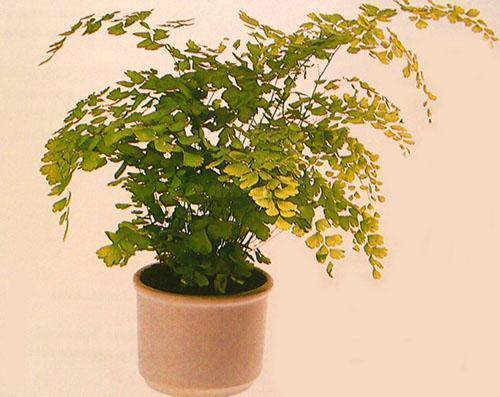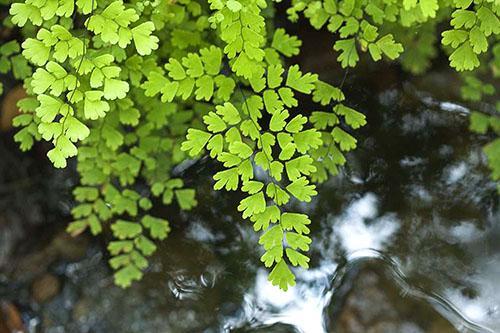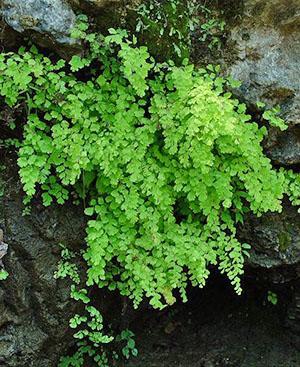Do you have a sick room maidenhair? We know how to help
 House flowers require special care. They silently ask for help, signaling discomfort with a droopy appearance, gray bloom, drying leaves. The florist's task is to understand in time what the indoor maidenhair or other pet is sick with, and to provide timely assistance. Only healthy plants will fill the house with coziness and health phytoncides, protect the aura and help restore mental balance.
House flowers require special care. They silently ask for help, signaling discomfort with a droopy appearance, gray bloom, drying leaves. The florist's task is to understand in time what the indoor maidenhair or other pet is sick with, and to provide timely assistance. Only healthy plants will fill the house with coziness and health phytoncides, protect the aura and help restore mental balance.
Homeland of the maidenhair

 The homeland of this plant is mountain crevices, hollows and gorges of the subtropics. Therefore, the fern needs at the same time:
The homeland of this plant is mountain crevices, hollows and gorges of the subtropics. Therefore, the fern needs at the same time:
- bright light, but shading from direct rays;
- warm, but not hot;
- fresh air, but no drafts;
- constant moisture in the air and ground, but without stagnation;
- in winter, the temperature should not fall below 10 0, and then not for long.
Under acceptable conditions, the fern reproduces by spores, they are numerous and are introduced into the litter all summer. It grows very quickly, doubling the green mass every year. Inhabiting the crevices between the rocks of the maidenhair, together with moss and lichens, it revives the warm rocky landscape of the tropics. Creeping rhizomes expand rapid colonization.
Home care for maidenhair
 Only by observing the conditions for the existence of the indoor maidenhair can you get a beautiful bush that brings balance and tranquility to the family. Therefore, when acquiring a new member of the community, you need to take care of creating conditions in advance.
Only by observing the conditions for the existence of the indoor maidenhair can you get a beautiful bush that brings balance and tranquility to the family. Therefore, when acquiring a new member of the community, you need to take care of creating conditions in advance.
For the maidenhair, a northern window is chosen or the plant is placed in a suspension so that the direct rays of the sun hardly touch it. The plant needs to be watered daily, but so that there is no stagnation of water. Showering once a week is encouraged. Irrigation water should be warm, soft, chlorine-free. Top dressing is not frequent and only with an extract from organic fertilizers.
In summer, the temperature in the room should be about 22 degrees, in winter around 16-18. In such an environment, and even with the spraying of leaves, the absence of drafts and tobacco smoke, the plant will be comfortable. If the soil is selected correctly, care is in accordance with the requirements, diseases and pests are not threatened by the maidenhair
Signs of pests and diseases of adiantums photo
It is possible to determine why the tugor of leaves has decreased for three reasons: they have dried up, flooded, diseases and pests have settled.
 An experienced hostess will feel the trouble long before the obvious manifestations of the disease. Taking care of her pet every day, she will notice:
An experienced hostess will feel the trouble long before the obvious manifestations of the disease. Taking care of her pet every day, she will notice:
- slight drooping of leaves;
- slowing growth;
- loss of shine of the leaves;
- the appearance of light or dark spots.
It's time to check if the containment conditions have changed. It should be borne in mind that in plants changes occur both for the better and for the worse for a long time, the analysis must be carried out over the last two weeks. Perhaps the cause will be found and eliminated immediately.
All diseases are classified as imported, infectious or physiological, from the wrong content. The appearance of insect pests is possible in any way. Measures are taken accordingly with the use of chemicals or changes in conditions of detention.
 In any case, only a weakened plant can get sick in a confined space, where a person will deliver the infection, in one way or another. Photo and video materials on the page will help to identify diseases of the maidenhair.
In any case, only a weakened plant can get sick in a confined space, where a person will deliver the infection, in one way or another. Photo and video materials on the page will help to identify diseases of the maidenhair.
The leaves of the maidenhair darken, brown dashes appear, this is a signal to check the acidity of the soil with a litmus test. It should be in the range of 5.5-6.5, be slightly acidic. Feeding mixtures can change the composition. Therefore, if the soil does not correspond to acidity, salts must have accumulated in it, which have alkalized the substrate. You can rinse the ground repeatedly with water, but replanting the plant will be better and less painful. First, you should check if the roots are flooded, if the flower is cold. If you do not take action at the first signal, blackening of the maidenhair leaves with drying will follow.
 Delicate foliage reacts with drying from the tips to any trouble. This is too high an air temperature, and tobacco smoke, and stagnation of an unventilated room. The sun's rays fall directly on the leaves and mummify them. If the leaves of the maidenhair dry out, starting from the tips, this is possible under the influence of drafts, from the rising air from the heating batteries, which is not only very warm, but also dry.
Delicate foliage reacts with drying from the tips to any trouble. This is too high an air temperature, and tobacco smoke, and stagnation of an unventilated room. The sun's rays fall directly on the leaves and mummify them. If the leaves of the maidenhair dry out, starting from the tips, this is possible under the influence of drafts, from the rising air from the heating batteries, which is not only very warm, but also dry.
Yellow foliage can tell you that the root system is failing, and problems arose there. But this color can also signal a lack. nitrogen fertilizers in top dressing. It is possible to conclude that there is a lack of nutrition and unhealthy roots if the maidenhair does not grow.
 If there are signs of disease or foci of rot on the roots, plant transplantation with replacement of soil and dishes is required. But at the same time, washed, treated roots must be kept in a fungicide solution. It is imperative to treat the soil against infection and add the recommended long-acting fungicide to the soil. for ferns... You can not use any, since ferns do not tolerate soil salinity. During treatment, watering should be scanty, feeding is excluded. It is better to reduce the stress on the plant by pruning the fronds. When reanimating the plant, you need to create comfortable thermal conditions.
If there are signs of disease or foci of rot on the roots, plant transplantation with replacement of soil and dishes is required. But at the same time, washed, treated roots must be kept in a fungicide solution. It is imperative to treat the soil against infection and add the recommended long-acting fungicide to the soil. for ferns... You can not use any, since ferns do not tolerate soil salinity. During treatment, watering should be scanty, feeding is excluded. It is better to reduce the stress on the plant by pruning the fronds. When reanimating the plant, you need to create comfortable thermal conditions.
If the leaves of the maidenhair darken from the edge, and later the bronze color is transmitted to the entire vayu, this is a viral disease from which there are no methods of getting rid of. You can transfer to other plants with the tool. You need to get rid of such a flower. This virus is spread by thrips.
 What if the maidenhair dries up for no apparent reason? Then you need to look for the invisible. Equip yourself with a magnifying glass and examine the plant for:
What if the maidenhair dries up for no apparent reason? Then you need to look for the invisible. Equip yourself with a magnifying glass and examine the plant for:
- spider mites on the back of the sheets;
- fern aphid;
- scabbards;
- thrips;
- mealybug.
 To treat all pests, you need to use a tobacco-soap solution. If home remedies do not help, then use actellic, fitoverm and karbofos. Removing it with an alcohol solution will help from the shield. Signs of the appearance of scale insects are accompanied by the appearance of brown scutes, under which they spread, spread out and become covered with new shells. As a result, they secrete a gum, on which a sooty fungus settles, the plant is doomed to death without help. The scabbard suffocates if the plant is wiped with an oil swab.
To treat all pests, you need to use a tobacco-soap solution. If home remedies do not help, then use actellic, fitoverm and karbofos. Removing it with an alcohol solution will help from the shield. Signs of the appearance of scale insects are accompanied by the appearance of brown scutes, under which they spread, spread out and become covered with new shells. As a result, they secrete a gum, on which a sooty fungus settles, the plant is doomed to death without help. The scabbard suffocates if the plant is wiped with an oil swab.
The strawberry nematode can settle on the fern, which feeds on the soft tissue of the leaves between the veins and stains them brown. They can be found if a moistened leaf is placed on a dark background. The mm long worms will become visible as they emerge from the leaves. All infected fronds should be removed from the plant. The maidenhair is dried so that the nematodes cannot move.
 The aphids spin the fronds, later they dry up.The fight against aphids is carried out with soapy water and complex chemical insecticides. If leaves dry on the maidenhair after preliminary discoloration, you need to look for a spider mite. They thrive in warm, dry air. In order to get rid of this pest, it will take three times the treatment with insecticides, the most harmless of which in the room will be fitoverm.
The aphids spin the fronds, later they dry up.The fight against aphids is carried out with soapy water and complex chemical insecticides. If leaves dry on the maidenhair after preliminary discoloration, you need to look for a spider mite. They thrive in warm, dry air. In order to get rid of this pest, it will take three times the treatment with insecticides, the most harmless of which in the room will be fitoverm.
 Thrips live on the underside of flower leaves. With strong reproduction, they cause drying leaves of the maidenhair. Thrips cannot be destroyed with home remedies. Only repeated treatments with strong preparations every 5 days can rid the plant of parasites.
Thrips live on the underside of flower leaves. With strong reproduction, they cause drying leaves of the maidenhair. Thrips cannot be destroyed with home remedies. Only repeated treatments with strong preparations every 5 days can rid the plant of parasites.
For the period of working with insecticides in the room, you need to take self-protective measures. Be sure to remove pets, birds, fish, animals and children from the premises.
However, lovers of indoor maidenhair should be reassured - the plant is rarely colonized by pests due to the special composition of the juice.